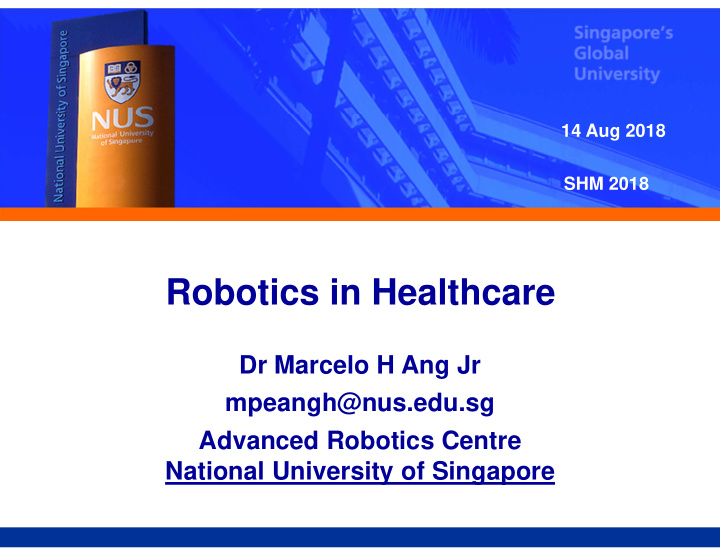



14 Aug 2018 SHM 2018 Robotics in Healthcare Dr Marcelo H Ang Jr mpeangh@nus.edu.sg Advanced Robotics Centre National University of Singapore
Moment of Great Opportunities 2000s 1980s, 1990s 2
Toward Everyday Robotics Structured Environment Unstructured Environment Human-Robot Human-Robot Interaction Separation Intelligent Robot Adapting to Factories designed Spaces Designed for Humans for robots
Autonomous Wheelchair in a Hospital Environment
Local Planning – our mobility scooter
Critical Needs Improving Productivity Ageing Population Manpower for Higher Value Added Services Robotics is a Key Solution The 5 D’s
Human-Centered Collaborative Robotics Develop the generic scientific foundations, technologies and experimental platforms that enable natural interaction and collaboration between robots and humans –What is the right level of autonomy? –How best to interact and collaborate? Apply them to compelling areas - high societal and economic impact 7
Industrial Robots: From Structured Environments to Unstructured & Human Environments Is Precision Motion Control Enough? What is the role of Force Control? Do we need new Design of Robots? Do we needed higher forms of intelligence?
Robotics in our daily lives Activities of Daily Living Social companionship Assistive Devices Exercise Devices Anytime, anywhere Hospital Community Workplace Home
What’s needed? Robotic Mechanisms –Inherently safe –Friendly –Easy to use Intelligence –Sensing and perception –Intelligent decisions and actions –Learning from experience (continuously)
Mechanical Intelligence Physical Embodiment – Intelligent Mechanics – Physically Soft and Compliant – Naturally comply to contact with environment (including humans) – Inherently safe Soft Robotics
Soft Robotics Pressure-based Actuation Concept Object Grasping Why? Hand • Compliant grasping Rehabilitation • Various actuations • Scalable • Mass production • Quick fabrication • MRI-safe Applications c) CAD • Grasping of organ or 3D-printing tissue structures Mix & Cure • Physical therapy • Sensing and haptics Raye CH Yeow (PhD) • Biodegradable Evolution Innovation Laboratory, Biomedical Engineering/SP-ARC
So ft Ac tuato rs
So ft Ro bo tic s. E xte nding.
So ft Ro bo tic s. Bending.
So ft Ro bo tic s. Crawling.
Soft Active Sheets Spreading Rolling Wrapping Winding frame for surface constraint M ot or Motor Cotton ized fiber Ard linear uin o slide
A ssist MyoGlove Soft Myoe le c tr ic Robotic Glove for Assistive Applic ations
A ssist E xoGlove R obot-assiste d Hand T he r apy
A ssist Mir r or Glove s Soft Se nsor -Robotic Glove s for Mir r or T he r apy
A ssist E xoSoc k Robot-assiste d Ankle T he r apy
A ssist Mir r or Soc ks Soft Se nsor -Robotic Soc ks for Mir r or T he r apy
Soft Grippers
3D Printing – “Ninjaflex”
A third Arm?
F ully-F ab ric Soft R obotic T ail
Hardware: Intelligent Mechanics Dielectric Elastomers 3M VHB 9610 (double sided tape) With Zhu Jian and Adrian Koh
with Adrian Koh Soo Jian
Domenico Campolo Nanyang Technological University School of Mechanical and Aerospace Engineering Simone Krager* and Marcelo H Ang Jr National University of Singapore Advanced Robotics Centre
A novel, compact planar robot for (semi-) independent rehabilitation of upper limb sensorimotor impairments • Light-weight (< 7 kg) • Max 30 N at the end-effector • Table top / portable • Cost-effective • Easy to control and program • Assistive/resistive tasks • Intrinsically safe 30
The H-Man Low-cost planar robot for upper-limb rehabilitation in a safe , productive and effective manner , backed by clinical validation H ‐ Man in Hospital Novel Smart Algorithm –Intensity & productivity Integrated sensors - Continuous Assessment Safety – Human Centric Design Low cost – Standard Manufacturing Clinical validation: Pilot Study (12 stroke patients) + RCT Development In use (44 Stroke patients – on ‐ going) 3
H-Man and Quantitative Sensorimotor Assessment Coordination Range of Motion 32
Training with H-Man preliminary results • 6 Stroke patients on H- on 13 patients out of 44 Man • 7 Stroke patients on traditional 1-1 therapy • Equivalent to traditional therapy after completion of randomized control trial 33
Towards Commercialization Clinically Validated Pain to Gain 2. Enhanced Productivity 1. Intensive Training 1 therapist > multiple patients, > 6 times more smart repetitions than validated smart algorithm. conventional methods, 50 vs 300. 3. Continuous Assessment 4. Safe & Portable Clinically validated metrics with table top design with clinically integrated sensors validated safety in feasibility study. 34 5. Low cost 4 times cheaper than MIT-Manus 34
H-Man Team Domenico Simone Muhammad Kumudu Asif CAMPOLO KAGER Azhar GAMAGE HUSSAIN Mohammad Paolo PHAN Aamani Sara ESMAEILI TOMMASINO Gia Hoang BUDHOTA CONTU overseas collaborators Karen Domenico Etienne 35 CHUA BURDET FORMICA
mpeangh@nus.edu.sg Marcelo H ANG Jr
Recommend
More recommend